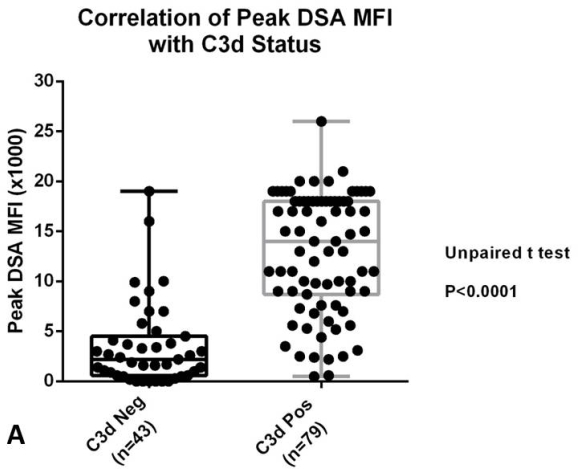Clinical Relevance of C3d-Binding Donor-Specific Antibodies in Late Kidney Allograft Failure
Path, UCLA, LA, CA.
Meeting: 2015 American Transplant Congress
Abstract number: 162
Keywords: Graft failure, Histocompatibility, HLA antibodies, Kidney transplantation
Session Information
Session Name: Concurrent Session: Antibodies and Graft Injury: Translational
Session Type: Concurrent Session
Date: Monday, May 4, 2015
Session Time: 2:15pm-3:45pm
 Presentation Time: 3:15pm-3:27pm
Presentation Time: 3:15pm-3:27pm
Location: Room 121-AB
Background: The objective of this study was to investigate the prognostic value of C3d-binding donor-specific antibodies (DSA) in determining late kidney allograft failure.
Methods: 1048 patients from the long-term deterioration of kidney allograft function (DeKAF) study underwent screening for DSA and concomitant kidney biopsy at the time of clinical dysfunction (>25% increase in Cr or new onset proteinuria). 134 recipients with known mod-strong DSA at the time of dysfunction were selected for this study, with a median time to biopsy of 4.2 yrs post-tx. 12 patients were excluded due to graft failure < 7 days post biopsy (7) and missing data (5). Sera from the final cohort of 122 patients were re-tested on the C3d platform to assess the complement activating capacity of the known DSA.
Results: The peak DSA's IgG MFI (mean fluorescence intensity) was strongly correlated with its C3d-binding status (A). Above a threshold of MFI>10K, almost all DSA showed the capacity to activate complement. Although there was general agreement between C3d and C4d positivity, the C3d assay demonstrated higher sensitivity, likely through its design to detect the C3 cleavage product situated downstream in the complement cascade. Overall, neither C3d positivity nor C4d deposition predicted allograft failure in this cohort of recipients with predominantly strong DSA – however, in the subgroup of patients with peak MFI<10K C3d positivity was associated with inferior graft survival (B, survival for 914 DSA Neg patients at biopsy were included for reference).
Conclusions: The prognostic value of the C3d assay needs to be considered in the context of the DSA's strength. Given the strong relationship between antibody strength and its ability to activate complement, the utility of the C3d assay is best served in discriminating the deleterious potential of weak-mod strength antibodies.


To cite this abstract in AMA style:
Lan J, Gjertson D, Zheng Y, Investigators DeKAF, Reed E, Cecka M. Clinical Relevance of C3d-Binding Donor-Specific Antibodies in Late Kidney Allograft Failure [abstract]. Am J Transplant. 2015; 15 (suppl 3). https://atcmeetingabstracts.com/abstract/clinical-relevance-of-c3d-binding-donor-specific-antibodies-in-late-kidney-allograft-failure/. Accessed December 14, 2025.« Back to 2015 American Transplant Congress
